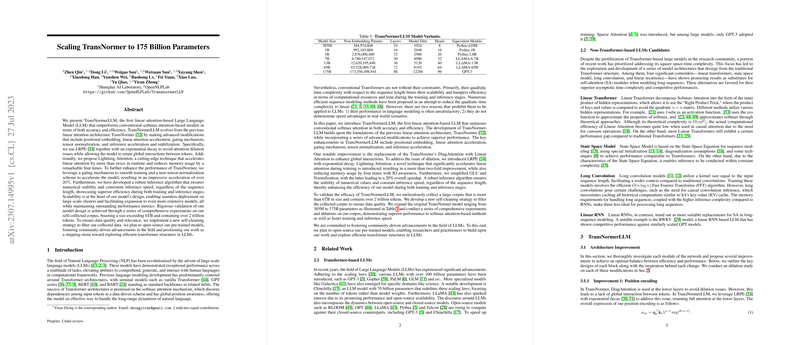An Analysis of TransNormerLLM: Advancements in Linear Attention-Based LLMs
The paper "TransNormerLLM: A Faster and Better LLM with Improved TransNormer" introduces a novel LLM architecture known as TransNormerLLM, which leverages a linear attention mechanism to deliver enhanced performance over conventional Transformer-based models. This exploration of linear attention in LLMs is particularly significant given the computational inefficiencies associated with softmax attention mechanisms, such as quadratic time complexity relative to sequence length.
Summary of Contributions
The TransNormerLLM architecture extends the TransNormer framework with several key modifications, focusing on improving accuracy and efficiency:
- Positional Encoding: The paper emphasizes the introduction of Linearized Relative Positional Encoding with exponential decay (LRPE-d), which maintains global token interaction and mitigates attention dilution. The empirical results suggest that LRPE-d significantly enhances model performance.
- Lightning Attention: A new linear attention technique termed Lightning Attention is proposed, doubling runtime speed and drastically decreasing memory usage. This advancement is pivotal in rendering the linear attention model more practical for real-world applications, especially for causal attention where efficiency gains are paramount.
- Optimized Architectural Components: The paper presents innovative uses of a gating mechanism and SimpleRMSNorm (SRMSNorm) normalization, contributing to faster training and inference by smoothing the training process and reducing complexity. These design enhancements cumulatively deliver over a 20% acceleration in performance.
- Robust Inference Mechanism: By ensuring stable numerical values during inference, the authors propose a robust inference algorithm that guarantees consistent speeds regardless of sequence length, which is a substantial improvement for scalable deployment.
- Scalability and Parallelization: A comprehensive model parallel schema is developed to support efficient scaling on large hardware clusters, extending up to models with 175 billion parameters. The implementation of Fully Sharded Data Parallelism (FSDP) and other optimization techniques mark significant advancements for large-scale pre-training exercises.
Results and Implications
The experiments conducted validate the superiority of TransNormerLLM over traditional state-of-the-art Transformer-based models, showing equivalent or superior performance in tasks such as commonsense reasoning, while also accelerating inference times. By demonstrating this efficacy across a range of model sizes from 385 million to 7 billion parameters, the research establishes TransNormerLLM as a promising architecture for commercial deployment and further exploration within LLMs.
The implications of this work suggest a potential shift in architectural paradigms for LLMs towards linear attention methodologies, which may enable more efficient training and deployment at scale. The evident reductions in computing resource requirements and improvements in execution speed indicate a bright future for such models in applications where rapid inference and resource conservation are critical.
Speculation on Future Developments
Looking forward, the TransNormerLLM architecture might influence future research, encouraging the exploration of even more efficient attention mechanisms or hybrid models that combine the benefits of linear and nonlinear attention structures. Additionally, the scalability potential demonstrated could lead to innovations in distributed training practices, allowing for the seamless deployment of models on diverse hardware setups, from edge devices to expansive data centers.
Overall, this research opens up new avenues for both theoretical exploration and practical application, driving the agenda towards increasingly capable and resource-efficient natural language processing models. As the field progresses, further refinements and applications of such architectures could play a pivotal role in the ubiquitous adoption of AI technologies in everyday linguistic applications.
